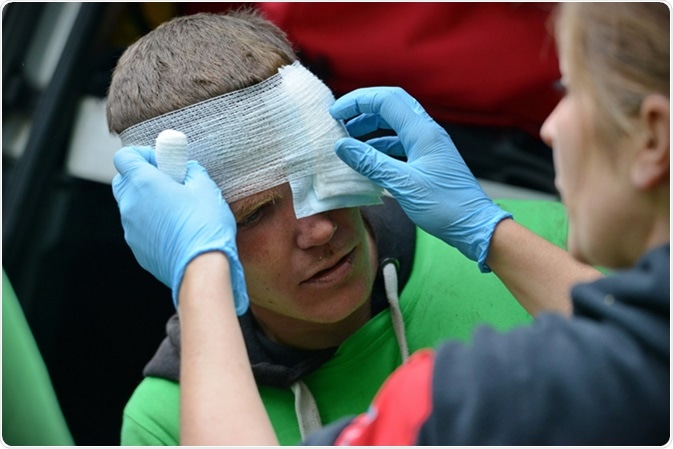First Aid for Cuts and Wounds
Cuts and wounds are injuries involving an external or internal break in body tissue, which can be caused by an external action and include bruising, cuts and hematomas. Wounds are extremely common, and most individuals will experience having one over their lifetime. Some of the wounds can be minor, requiring home treatment, while others, may be life-threatening and need further medical attention.

What are Wounds?
Cuts or wounds are described as an injury that harms the body and can be caused by falls, accidents, and contact with weapons. Wounds are injuries that break the skin or other body tissues, including scrapes, punctures, cuts, and scratches.
Usually, minor wounds are treated at home. However, serious and infected wounds may need first aid followed by further medical attention from a doctor. It’s important to seek medical treatment for deep wounds since these may lead to hemorrhage or bleeding. Wounds should also be cleaned thoroughly to prevent infection.
Types of Cuts and Wounds
Wounds can be classified as open or closed. Closed wounds do not expose any underlying tissue to the environment. The converse is seen with open wounds which take several forms.
Types of Open Wounds
Abrasion
An abrasion involves the scraping of the outer layer of the skin against a rough or hard surface. In this type of wound, there is not much bleeding, but the wound still needs to be cleaned thoroughly to prevent infection.
Laceration
A laceration refers to an injury caused by the tearing of tissue. It’s a deep cut usually caused by accidents with tools, machinery, and knives. In this type of wound, deep cuts are present and bleeding can be extensive. Due to the high force involved in the tearing of the tissue, damage to muscles, tendons, bones and blood vessels in the surrounding area can be caused.
Incision
An incision is a clean cut in the skin caused by a sharp tool or object. If an individual accidentally cuts themselves with a kitchen knife or a pair of scissors, it can result in an incision cut. Another type of incision is a surgical incision wherein the doctor cuts through the skin to gain access to the internal parts of the body for a surgical procedure.
Puncture
A puncture is a small hole caused by a long and pointy tool or object, such as a nail. In some instances, a bullet can also cause a puncture wound. Though puncture wounds do not bleed heavily, they can be dangerous and life-threatening since they can damage internal organs.
Avulsion
An avulsion is the partial or complete tearing away of the skin. This type of wound usually happens during violent accidents, including car accidents and injuries inflicted by gunshots and exposure to explosions. These wounds may bleed heavily leading to the development of life-threatening complications..
Treating Cuts and Wounds
Minor wounds can be treated at home. But, more serious and deep wounds may require medical attention.
First Aid Treatment
For cuts and wounds, it’s important to always make sure you clean the wound thoroughly to prevent infection. Here’s the first aid treatment for cuts and wounds.
- Wash hands – Before treating or applying any first aid treatments to an open wound, it’s important to wash your hands first. This helps keep the wound clean and prevent infection.
- Stop the bleeding – The next important step in wound care is to stop the bleeding. For deep wounds like lacerations and avulsions, it’s the utmost priority to stop the hemorrhage to prevent hypovolemic shock, which is potentially fatal. Apply gentle pressure with a clean cloth or bandage. Elevate the wound until the bleeding stops.
- Clean the cut or wound – After making sure the wound has stopped bleeding, rinse the wound with clean water for about five minutes. Make sure dirt and debris are removed. You can clean the wound with soap and water.
- Disinfect – To prevent infection, apply a topical antiseptic.
- Dress the wound – Cover the wound with a sterile gauze pad with dressing and secure with adhesive tapes. However, for minor scrapes or abrasions, you can leave the wound uncovered.
- Refer to a physician or hospital – If the wound is deep and there’s heavy bleeding, refer the patient to a physician or bring them to hospital. Deep wounds that bleed heavily may require more intensive treatment such as suturing or other surgical procedures.
- Watch out for signs of hypovolemic shock – For patients with heavy bleeding, always look for the signs of hypovolemic shock, including palor, cyanosis or clammy skin, weak and rapid pulse, irregular breathing, and weakness.
Sources
- https://medlineplus.gov/ency/article/000043.htm
- www.betterhealth.vic.gov.au/…/skin-cuts-and-abrasions
- http://healthywa.wa.gov.au/Articles/U_Z/Wounds-first-aid
- https://cpraedcourse.com/course/hc_fa_bp/22
- https://www.redcross.org.uk/first-aid/learn-first-aid/bleeding-heavily
Further Reading
- All First Aid Content
- How to Perform CPR
- What is an Adrenaline Auto Injector?
- When Should an Adrenaline Auto-Injector be Used?
- Alcohol Poisoning: What To Do
Last Updated: Oct 16, 2018

Written by
Angela Betsaida B. Laguipo
Angela is a nurse by profession and a writer by heart. She graduated with honors (Cum Laude) for her Bachelor of Nursing degree at the University of Baguio, Philippines. She is currently completing her Master's Degree where she specialized in Maternal and Child Nursing and worked as a clinical instructor and educator in the School of Nursing at the University of Baguio.
Source: Read Full Article


